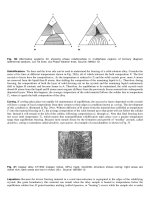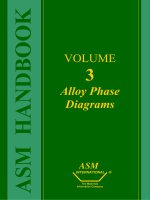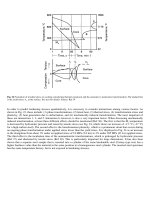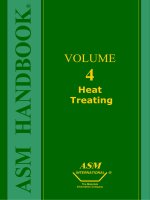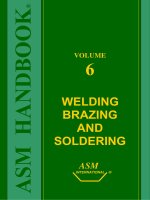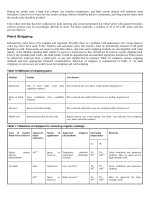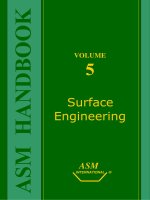Smithells Light Metals Handbook Edited byE. A. Brandes CEng potx
Bạn đang xem bản rút gọn của tài liệu. Xem và tải ngay bản đầy đủ của tài liệu tại đây (1.76 MB, 200 trang )
Smithells Light Metals Handbook
Smithells Light Metals
Handbook
Edited by
E. A. Brandes CEng, BSc(Lond), ARCS, FIM
and
G. B. Brook DMet(Sheff), FEng, FIM
Butterworth-Heinemann
Linacre House, Jordan Hill, Oxford OX2 8DP
225 Wildwood Avenue, Woburn, MA 01801-2041
A division of Reed Educational and Professional Publishing Ltd
OXFORD BOSTON JOHANNESBURG
MELBOURNE NEW DELHI SINGAPORE
First published 1998
Reed Educational and Professional Publishing Ltd 1998
All rights reserved. No part of this publication may be reproduced in
any material form (including photocopying or storing in any medium by
electronic means and whether or not transiently or incidentally to some
other use of this publication) without the written permission of the
copyright holder except in accordance with the provisions of the Copyright,
Designs and Patents Act 1988 or under the terms of a licence issued by the
Copyright Licensing Agency Ltd, 90 Tottenham Court Road, London,
England W1P 9HE. Applications for the copyright holder’s written
permission to reproduce any part of this publication should be addressed
to the publishers
British Library Cataloguing in Publication Data
A catalogue record for this book is available from the British Library
ISBN 0 7506 3625 4
Library of Congress Cataloguing in Publication Data
A catalogue record for this book is available from the Library of Congress
Typeset by Laser Words, Madras, India
Printed and bound in Great Britain by Hartnolls Ltd, Bodmin, Cornwall
Contents
Preface vii
1 Related specifications 1
Related specifications for wrought aluminium alloys 2
Related specifications for magnesium alloys 3
Titanium and titanium alloys
corresponding grades or specifications 3
2 General physical properties of light metal alloys and pure light
metals
5
2.1 General physical properties of pure light metals and their alloys 5
2.2 The physical properties of aluminium and aluminium alloys 6
2.3 The physical properties of magnesium and magnesium alloys 10
2.4 The physical properties of titanium and titanium alloys 13
3 Mechanical properties of light metals and alloys 14
3.1 Mechanical properties of aluminium and aluminium alloys 14
Alloy designation system for wrought aluminium 14
Temper designation system for aluminium alloys 15
3.2 Mechanical properties of magnesium and magnesium alloys 40
3.3 Mechanical properties of titanium and titanium alloys 55
4 Aluminium and magnesium casting alloys 67
4.1 Aluminium casting alloys 68
4.2 Magnesium alloys 80
vi Contents
5 Equilibrium diagrams 93
5.1 Index of binary diagrams 93
6 Metallography of light alloys 163
6.1 Metallographic methods for aluminium alloys 163
6.2 Metallographic methods for magnesium alloys 168
6.3 Metallographic methods for titanium alloys 171
7 Heat treatment of light alloys 173
7.1 Aluminium alloys 173
Annealing 173
Stabilizing 173
Hardening 173
7.2 Magnesium alloys 176
Safety requirements 176
Environment 176
Conditions for heat treatment of magnesium alloys castings 176
8 Metal finishing 179
8.1 Cleaning and pickling processes 179
Vapour degreasing 179
Emulsion cleaning 179
8.2 Anodizing and plating processes 182
8.3 Plating processes for magnesium alloys 185
Dow process (H. K. Delong) 185
Conditions 185
Electroless plating on magnesium 185
‘Gas plating’ of magnesium (vapour plating) 185
9 Superplasticity of light metal alloys 186
10 Light metal-matrix composites 188
Index 193
Preface
The light metals covered by this handbook are only those of industrial importance aluminium,
magnesium and titanium. The values given have been updated to the time of publication. They
are intended for all those working with light metals; for research or design purposes Reference
to source material may be found in Smithells Metals Reference Book (revised 7th edition). For
design purpose values of mechanical properties must be obtained from the relevant specifications.
Equilibrium diagrams are taken to be the most suitable for general work. For specialist work on any
system, original sources should be consulted.
E.A.B.
Chalfont St Peter, Bucks
1 Related specifications
2 Smithells Light Metals Handbook
Table 1.1 RELATED SPECIFICATIONS FOR WROUGHT ALUMINIUM ALLOYS
Nominal
composition UK
BS old ISO No. former BS France W. Germany Italy
international Al designation former NF Wk. No. Canada Sweden USSR Old UNI New UNI Japan
1050A 99.5 1B A5 3.0255 4 007 4 507 9001/2 A1050
1080A 99.8 1A A8 3.0285
4 004 4 509 9001/4 A1080
1200 99 1C A4 3.0205 990 4 010
3 567 9001/1 A1200
1350 99.5 1E A5/6 3.0257
9001/5
2011 Cu6BiPb FC1 A U5 PbBi 3.1655 CB60 4 355 6 362 9002/5 A2011
2014A Cu4SiMg H15 A
U4SG 3.1255 CS41N 4338 AK 8 3 581 9002/3 A2014
2017A Cu4MgSi
A U4G 3.1325
2024 Cu4Mg1 2L97, 2L98, A U4G1 3.1355 CG42 D 16 3 583 9002/4 A2024
L109, L110,
DTD5100A
2031 Cu2NiMgFeSi H12 A
U2N
2117 Cu2Mg 3L86 A U2G 3.1305 CG30 D 18 3 577 9002/1 A2217
2618A Cu2Mg1.5 H16 A
U2GN AK 4-1 3578 9002/6
Fe1Ni1
3103 Mn1 N3
3.0515 4054 3 568 9003/3
3105 MnMg N31 3.0505 9003/5 A3105
4043 Si5 N21 A
S5 A4043
4047 Si12 N2 A
S12
5005 Mg1 N41 A G0.6 4106 5 764 9005/1 A5005
5056A Mg5 N6 A
G5M 3.3555
5083 Mg4.5Mn N8 A G4.5MC 3.3547 GM41 4140 7 790 9005/5 A5083
5154A Mg3.5 N5
GR40 AMG3
5251 Mg2 N4 A G2M 3.3525 3 574
5454 Mg3.6 N51 A G2.5MC 3.3537 GM31N 7 789 9005/3 A5454
5554 Mg3Mn N52
GM31P A5554
6061 Mg1SiCu H20 A
GSUC 3.3211 GS11N AD3 6170 9006/2 A6061
6063 Mg0.5Si H9
GS10 4104 AD31 A6063
6082 Si1MgMn H30 A
SGM0.7 3.2315 4 212 3 571 9006/4
7020 Zn4.5Mg H17 A Z5G 3.4335 4 425 7 791 9007/1
7075 Zn6MgCu 2L95, L160, A Z5GU 3.4365 ZG62 SM6958 V95 3 735 9007/2 A7075
L161, L162
Related specifications 3
Table 1.2 RELATED SPECIFICATIONS FOR MAGNESIUM ALLOYS
Cast alloys
UK
Nominal UK BS2970 USA USA France Standard W. Germany W. Germany
composition designation MAG ASTM AMS AFNOR AECMA aircraft DIN 1729
RE3Zn2.5 ZRE1 6-TE EZ33A-T5 4442B G-TR3Z2 MG-C-91 3.6204 3.5103
Zr0.6
Zn4.2RE1.3 RZ5 5-TE ZE41A-T5 4439A G-Z4TR MG-C-43 3.6104 3.5101
Zr0.7
Th3Zn2.2 ZT1 8-TE HZ32A-T5 4447B G-Th3Z2 MG-C-81 3.6254 3.5105
Zr0.7
Zn5.5Th1.8 TZ6 9-TE ZH62A-T5 4438B
MG-C-41 3.5114 3.5102
Zr0.7
Al8Zn0.5 A8 1-M AZ81A-F
G-A9 MG-C-61 3.5812
Mn0.3
Al9.5Zn0.5 AZ91 3-7B AZ91C-T4
G-A9Z1 3.5194
Mn0.3
Al7.5/9.5 C 7-M
3.5912
Zn0.3/1.5
Mn0.15min
1.4.2 Wrought alloys
Zn3Zr0.6 ZW3 E-151M
MG-P-43
Al6Zn1Mn0.3 AZM E-121M AZ61A-F 4350H G-A6Z1 MG-P-63 W.3510 3.5612
Al8.5Zn0.5 AZ80
AZ80A 4360D MG-P-61 W.3515 3.5812
Mn0.12min
Al3Zn1Mn0.3 AZ31 S-1110 AZ31B-0 4375F G-A2Z1 MG-P-62 W.3504 3.5312
Table 1.3 TITANIUM AND TITANIUM ALLOYS. CORRESPONDING GRADES OR SPECIFICATIONS
UK
British Standards
(Aerospace series) France AECMA
IMI and Min. of Def. AIR-9182, Germany recom- USA USA
designation DTD series
Ł
9183, 9184 BWB series
†
mendations AMS series
‡
ASTM series
IMI 115 BS TA 1, T-35 3.7024 Ti-POI ASTM grade 1
DTD 5013
IMI 125 BS TA 2,3,4,5 T-40 3.7034 Ti-PO2 AMS 4902, 4941, 4942, ASTM grade 2
4951
IMI 130 DTD 5023, 5273, T-50 AMS 4900 ASTM grade 3
5283, 5293
IMI 155 BS TA 6 AMS 4901
T-60 3.7064 Ti-PO4
ASTM grade 4
IMI 160 BS TA 7,8,9 AMS 4921
IMI 230 BS TA 21, 22, T-U2. 3.7124 Ti-P11
23, 24,
BS TA 52
55, 58
IMI 315 DTD 5043
IMI 317 BS TA 14, 15, T-A5E Ti-P65 AMS 4909, 4910, 4926,
16, 17 4924, 4953, 4966
IMI 318 BS TA 10, 11, T-A6V 3.7164 Ti-P63 AMS 4911, 4928, 4934, ASTM grade 5
12, 13, 28, 56 4935, 4954, 4965, 4967
IMI 318
ELI
(extra
low
interstitial)
T-A6VELI AMS 4907, ASTM grade 3,
4930, 4931 F. 136.
continued overleaf
4 Smithells Light Metals Handbook
Table 1.3 (continued)
UK
British Standards
(Aerospace series) France AECMA
IMI and Min. of Def. AIR-9182, Germany recom- USA USA
designation DTD series
Ł
9183, 9184 BWB series
†
mendations AMS series
‡
ASTM series
IMI 325 T-A3V2.5 3.7194 AMS 4943 ASTM grade 9
4944
IMI 550 BS TA 45
51, 57 T-A4DE 3.7184 Ti-P68
IMI 551 BS TA 39
42
IMI 624
T-A6Zr4 3.7144 AMS 4919,
DE 4975, 4976
IMI 646
AMS 4981
IMI 662
3.7174 AMS 4918,
4971, 4978,
4979
IMI 679 BS TA 18
20, AMS 4974
25-27
IMI 680 DTD 5213 T-E11DA
IMI 685 BS TA 43, 44 T-A6ZD 3.7154 Ti-P67
IMI 811
T-A8DV AMS 4915,
4916
IMI 834
T-A6E
Zr4Nb
Ł
UK BS 3531 Part 1 (Metal Implants in Bone Surgery), and Draft British Standard for Lining of Vessels and Equipment for Chemical
Processes, Part 9, also refer.
†
Germany DIN 17850, 17860, 17862, 17863, 17864 (3.7025/35/55/65), and TUV 230-1-68 Group I, II, III and IV also refer.
‡
USA MIL-T-9011, 9046, 9047, 14577, 46038, 46077, 05-10737 and ASTM B265-69, B338-65, B348-59T, B367-61T. B381-61T,
B382-61T also refer.
2 General physical properties of light
metal alloys and pure light metals
2.1 General physical properties of pure light metals and their alloys
Table 2.1 PHYSICAL PROPERTIES OF ALUMINIUM, MAGNESIUM AND TITANIUM
Property Aluminium Magnesium Titanium
Atomic weight C D 12 26.98154 24.305 47.88
Atomic number 13 12 22
Density (g cm
1
) 2.70 1.74 4.5
liquid at 660
°
C Al, 651
°
C Mg, 1685
°
C Ti 2.385 1.590 4.11
Melting point
°
C 660.323 649 1667
(fixed pt ITS-90)
Boiling point
°
C 2520 1090 3285
Thermal conductivity Wm
1
K
1
at
°
C
0
100 238 155.5 16
200 238 167 15
400 238 130 14
600
13
800
(13)
Specific heat Jkg
1
K
1
at
°
C
20 900 1022 519
0
100 917 1038 528
200 984 1110 569
300 1030
400 1076 1197 619
600
636
800
682
Coefficient of expansion 10
6
K
1
at
°
C
0
100 23.5 26.0 8.9
100 23.9 26.1 8.8
200 24.3 27.0 9.1
300 25.3
400 26.49 28.9 9.4
600
9.7
800
9.9
Electrical resistivity at
°
C
20 2.67 4.2 54
100 3.55 5.6 70
200 4.78 7.2 88
300 5.99
400 7.30 12.1 119
600
152
800
165
Temp. coefficient of resistivity 0
100
°
C10
3
K
1
4.5 4.25 3.8
Note: For surface tension and viscosity of liquid metals see Metal Reference Book 7th ed. pp. 14 7to14 8
6 Smithells Light Metals Handbook
2.2 The physical properties of aluminium and aluminium alloys
Table 2.2 THE PHYSICAL PROPERTIES OF ALUMINIUM AND ALUMINIUM ALLOYS AT NORMAL TEMPERATURES
sand cast
Coefficient of Thermal
Nominal expansion conductivity Modulus of
composition Density 20
100
°
C 100
°
C Resistivity elasticity
Material % gcm
3
10
6
K
1
Wm
1
K
1
µm MPa ð10
3
Al Al 99.5 2.70 24.0 218 3.0 69
Al 99.0 2.70 24.0 209 3.1
Al Cu Cu 4.5 2.75 22.5 180 3.6 71
Cu 8 2.83 22.5 138 4.7
Cu 12 2.93 22.5 130 4.9
Al Mg Mg 3.75 2.66 22.0 134 5.1
Mg 5 2.65 23.0 130 5.6
Mg 10 2.57 25.0 88 8.6 71
Al
Si Si 5 2.67 21.0 159 4.1 71
Si 11.5 2.65 20.0 142 4.6
Al Si Cu Si 10 2.74 20.0 100 6.6 71
Cu 1.5
Si 4.5 2.76 21.0 134 4.9 71
Cu 3
Al
Si Cu Mg
Ł
Si 17 2.73 18.0 134 8.6 88
Cu 4.5
Mg 0.5
Al
Cu Mg Ni Cu 4 2.78 22.5 126 5.2 71
(Yalloy) Mg 1.5
Ni 2
Al
Cu Fe Mg Cu 10 2.88 22.0 138 4.7 71
Fe 1.25
Mg 0.25
Al
Si Cu Mg Ni Si 12 2.71 19.0 121 5.3 71
(Lo
Ex) Cu 1
Mg 1
Ni 2
Si 23 2.65 16.5 107
88
Cu 1
Mg 1
Ni 1
Ł
Die cast.
General physical properties of light metal alloys and pure light metals 7
Table 2.3 THE PHYSICAL PROPERTIES OF ALUMINIUM AND ALUMINIUM ALLOYS AT NORMAL TEMPERATURES
wrought
Coefficient
of Thermal Temp.
Nominal expansion conductivity coeff. of Modulus of
composition Density 20
100
°
C 100
°
C Resistivity resistance elasticity
Specification % Condition
Ł
gcm
3
10
6
K
1
Wm
1
K
1
µcm 20 100
°
C MPa ð10
3
1199 Al 99.992 Sheet H111 239 2.68 0.0042 69
H18 2.70 23.5 234 2.70 0.0042 69
Extruded 239 2.68 0.0042 69
1080A Al 99.8 Sheet H111 234 2.74 0.0042 69
H18 2.70 23.5 230 2.76 0.0042 69
Extruded 230 2.79 0.0041 69
1050A Al 99.5 Sheet H111 230 2.80 0.0041 69
H18 2.71 23.5 230 2.82 0.0041 69
Extruded 226 2.85 0.0041 69
1200 Al 99 Sheet H111 226 2.87 0.0040 69
H18 2.71 23.5 226 2.89 0.0040 69
Extruded 226 2.86 0.0040 69
2014A Cu 4.4 T4 2.8 22 142 5.3 74
Mg 0.7 T6 2.8 22 159 4.5
Si 0.8
Mn 0.75
2024 Cu 4.5 T3 2.77 23 5.7 73
Mg 1.5 T6 2.77 23 151 5.7 73
Mn 0.6
2090 Cu 2.7 T8 2.59 23.6 88.2 9.59 76
Li 2.3
Zr 0.12
2091 Cu 2.1 T8 2.58 23.9 84 9.59 75
Li 2.0
Mg 1.50
Zr 0.1
3103 Mn 1.25 Sheet H111
H12
H14 2.74 23.0 180 3.9 0.0030 69
H16
H18
Extruded 151 4.8 0.0024
continued overleaf
8 Smithells Light Metals Handbook
Table 2.3 (continued)
wrought
Coefficient
of Thermal Temp.
Nominal expansion conductivity coeff. of Modulus of
composition Density 20
100
°
C 100
°
C Resistivity resistance elasticity
Specification % Condition
Ł
gcm
3
10
6
K
1
Wm
1
K
1
µcm 20 100
°
C MPa ð10
3
5083 Mg 4.5 Sheet H111 2.67 24.5 109 6.1 0.0019 71
Mn 0.7 H12
Cr 0.15 H14
5251 Mg 2.0 Sheet H111 2.69 24 155 4.7 0.0025 70
Mn 0.3 H13
H16
Extruded 147 4.9 0.0023
5154A Mg 3.5 Sheet H111 142 5.3 0.0021 70
H14 2.67 23.5 138 5.4 0.0021
Extruded 134 5.7 0.0019
5454 Mg 2.7 Sheet H111 2.68 24 147 5.1 70
Mn 0.75 H22
Cr 0.12 H24
Al
Li Li 2.0 Sheet T6 2.56 77
Al
Mg Li Mg 3.0 Sheet T6 2.52 79
Li 2.0
Al
Li Mg Li 3.0 Sheet T6 2.46 84
Mg 2.0
6061 Mg 1.0 Bar H111 2.7 23.6 180 68.9
Si 0.6 T4 2.7 23.6 154 68.9
Cu 0.2 T6 2.7 23.6 167 68.9
Cr 0.25
6063 Mg 0.5 Extruded T4 2.70 23.0 193 3.5 0.0033 71
Si 0.5 T6 201 3.3 0.0035
6063A Mg 0.5 Bar T4 2.7 24 197 3.5 69
Si 0.5 T5 24 209 3.2 69
T6 24 201 3.3 69
6082 Mg 1.0 Bar/Extruded T4 2.7 23 172 4.1 0.0031 69
Si 1.0 T6 2.7 23 184 3.7 0.0031 69
Mn 0.7
6082 Mg 1.0 Sheet T4 188 3.6 0.0033 69
Si 1.0 T6 2.69 23.0 193 3.4 0.0035
General physical properties of light metal alloys and pure light metals 9
6463 Mg 0.65 Bar T5 2.71 23.4 209 3.1 69
Si 0.4 T6 2.71 23.4 201 3.3 69
Al
Cu Mg Si Cu 4.0 Sheet T6 2.80 22.5 147 5.0 0.0023 73
(Duralumin) Mg 0.6
Si 0.4
Mn 0.6
Cu 4.5 Sheet T4 2.81 22.5 147 5.2 0.0022 73
Mg 0.5 T6 159 4.5 0.0026
Si 0.75
Mn 0.75
Al
Cu Mg Ni Cu 4.0 Forgings T6 2.78 22.5 151 4.9 0.0023 72
(Yalloy) Mg 1.5
Ni 2.0
Al
Si Cu Mg Si 12.0 Forgings T6 2.66 19.5 151 4.9 0.0023 79
(Lo
Ex) Cu 1.0
Mg 1.0
Ni 1.0
Al
Zn Mg Zn 10.0 Forgings 2.91 23.5 151 4.9 0.0023
Cu 1.0
Mn 0.7
Mg 0.4
7075 Zn 5.7 Extrusion T6 2.80 23.5 130 5.7 0.0020 72
Mg 2.6
Cu 1.6
Cr 0.25
8090 Li 2.5 Plate 2.55 21.4 93.5 9.59 77
Cu 1.3
Mg 0.95
Zr 0.1
H111 D Annealed. T4 D Solution treated and naturally aged.
H12,22 D Quarter hard. T6 D Solution treated and artificially aged.
H14,24 D Half hard.
H16,26 D Three-quarters hard.
H18,28 D Hard.
10 Smithells Light Metals Handbook
2.3 The physical properties of magnesium and magnesium alloys
Table 2.4 THE PHYSICAL PROPERTIES OF SOME MAGNESIUM AND MAGNESIUM ALLOYS AT NORMAL TEMPERATURE
Coeff. of
thermal
Nominal Density Melting point expansion Thermal Electrical Specific heat Weldability Relative
composition
†
at 20
°
C
°
C20200
°
C conductivity resistivity 20 200
°
C by argon arc damping
Material % Condition gcm
3
Sol. Liq. 10
6
K
1
Wm
1
K
1
µcm Jkg
1
K
1
process
‡
capacity
§
Pure Mag Mg 99.97 T1 1.74 650 27.0 167 3.9 1 050 A
Mg
Mn (MN70)Mn 0.75 approx. T1 1.75 650 651 26.9 146 5 1050 A
(AM503)Mn 1.5 T1 1.76 650 651 26.9 142 5.0 1050 A C
Mg
Al AL80Al 0.75 approx. T1 1.75 630 640 26.5 117 6 1050 A
Be 0.005
Mg
Al Zn (AZ31)Al 3 T1 1.78 575 630 26.0 (84) 10.0 1050 A
Zn 1
(A8)Al 8 AC 1.81 475
Ł
600 27.2 84 13.4 1000 A C
Zn 0.5 AC T4 1.81 27.2 84
1 000
(AZ91)Al 9.5 AC 1.83 470
Ł
595 27.0 84 14.1 1000 A C
Zn 0.5 AC T4 1.83 27.0 84
1 000
AC T6 1.83 27.0 84
1 000
(AZM)Al 6 T1 1.80 510 610 27.3 79 14.3 14 000 A
Zn 1
(AZ855)Al 8 T1 1.80 475
Ł
600 27.2 79 14.3 1000 A
Zn 0.5
Mg
Zn Mn (ZM21)Zn 2 T1 1.78 27.0 A
Mn 1
Mg
Zn Zr (ZW1)Zn 1.3 T1 1.80 625 645 27.0 134 5.3 1000 A A
Zr 0.6
(ZW3)Zn 3 T1 1.80 600 635 27.0 125 5.5 960 C
Zr 0.6
(Z5Z)Zn 4.5 AC T6 1.81 560 640 27.3 113 6.6 960 C
Zr 0.7
(ZW6)Zn 5.5 T5 1.83 530 630 26.0 117 6.0 1050 C
Zr 0.6
General physical properties of light metal alloys and pure light metals 11
Mg Y RE Zr (WE43)Y 4.0 AC T6 1.84 550 640 26.7 51 14.8 966 A
RE() 3.4
Zr 0.6
(WE54)Y 5.1 AC T6 1.85 550 640 24.6 52 17.3 960 A
RE() 3.0
Zr 0.6
Mg
RE Zn Zr (ZRE1)RE 2.7 AC T5 1.80 545 640 26.8 100 7.3 1 050 A B
ZN 2.2
Zr 0.7
(RZ5)Zn 4.0 AC T5 1.84 510 640 27.1 113 6.8 960 B
RE 1.2
Zr 0.7
(ZE63)Zn 6 AC T6 1.87 515 630 27.0 109 5.6 960 A
RE 2.5
Zr 0.7
Mg
Th Zn Zr
ŁŁ
(ZTY)Th 0.8 T1 1.76 600 645 26.4 121 6.3 960 A
Zn 0.5
Zr 0.6
(ZT1)Th 3.0 AC T5 1.83 550 647 26.7 105 7.2 960 A (B)
Zn 2.2
Zr 0.7
(TZ6)Zn 5.5 AC T5 1.87 500 630 27.6 113 6.6 960 B
Th 1.8
Zr 0.7
Mg
Ag RE Zr (QE22)Ag 2.5 AC T6 1.82 550 640 26.7 113 6.85 1000 A
RE(D) 2.0
Zr 0.6
(EQ21)RE(D) 2.2 AC T6 1.81 540 640 26.6 113 6.85 1000 A
Ag 1.5
Cu 0.07
Zr 0.7
continued overleaf
12 Smithells Light Metals Handbook
Table 2.4 (continued)
Coeff. of
thermal
Nominal Density Melting point expansion Thermal Electrical Specific heat Weldability Relative
composition
†
at 20
°
C
°
C20200
°
C conductivity resistivity 20 200
°
C by argon arc damping
Material % Condition gcm
3
Sol. Liq. 10
6
K
1
Wm
1
K
1
µ cm J kg
1
K
1
process
‡
capacity
§
Mg Zn Cu Mn (ZC63)Zn 6.0 AC T6 1.87 465 600 26.0 122 5.4 962 B
Cu 2.7
Mn 0.5
(ZC71)Zn 6.5 T6 1.87 465 600 26.0 122 5.4 62 B
Cu 1.3
Mn 0.8
MG
Ag RE
ŁŁ
Th Zr (QH21)Ag 2.5
RE(D) 1.0 AC T6 1.82 540 640 26.7 113 6.85 1005 A
Th 1.0
Zr 0.7
Mg
Zr (ZA)Zr 0.6 AC 1.75 650 651 27.0 (146) (4.5) 1050 A A
AC Sand cast. T1 Extruded, rolled or forged.
‡
Weldability rating:
§
Damping capacity rating:
T4 Solution heat treated. RE Cerium mischmetal containing
approx. 50% Ce.
A Fully weldable. A Outstanding.
T5 Precipitation heat treated.
Ł
Non-equilibrium solidus 420
°
C. B Weldable. B Equivalent to cast iron.
T6 Fully heat treated. () Estimated value. C Not recommended where fusion
welding is involved.
†
Mg
Al type alloys normally
contain 0.2
0.4% Mn to improve
corrosion resistance.
RE(D) Mischmetal enriched in
neodynium.
C Inferior to cast iron but better than Al-base
cast alloys.
ŁŁ
Thorium containing alloys are
being replaced by alternative Mg
alloys.
RE() Neodynium + Heavy Rare
Earths.
General physical properties of light metal alloys and pure light metals 13
2.4 The physical properties of titanium and titanium alloys
Table 2.5 PHYSICAL PROPERTIES OF TITANIUM AND TITANIUM ALLOYS AT NORMAL TEMPERATURES
Temp.
Coefficient Thermal coefficient Magnetic
of con- of Specific suscept.
Material Nominal expansion ductivity Resistivity resistivity heat 10
6
IMI composition Density 20 100
°
C20100
°
C20
°
C20100
°
C50
°
C cgs units
designation % gcm
3
10
6
K
1
Wm
1
K
1
µcm µ cm K
1
Jkg
1
K
1
g
1
CP Titanium Commercially 4.51 7.6 16 48.2 0.0022 528 C3.4
pure
IMI 230 Cu 2.5 4.56 9.0 13 70 0.0026
IMI 260/261 Pd 0.2 4.52 7.6 16 48.2 0.0022 528
IMI 315 Al 2.0 4.51 6.7 8.4 101.5 0.0003 460 C4.1
Mn 2.0
IMI 317 Al 5.0 4.46 7.9 6.3 163 0.0006 470 C3.2
Sn 2.5
IMI 318 Al 6.0 4.42 8.0 5.8 168 0.0004 610 C3.3
V 4.0
IMI 550 Al 4.0 4.60 8.8 7.9 159 0.0004
Mo 4.0
Sn 2.0
Si 0.5
IMI 551 Al 4.0 4.62 8.4 5.7 170 0.0003 400 C3.1
Mo 4.0
Sn 4.0
Si 0.5
IMI 679 Sn 11.0 4.84 8.0 7.1 163 0.0004
Zr 5.0
Al 2.25
Mo 1.0
Si 0.2
IMI 680 Sn 11.0 4.86 8.9 7.5 165 0.0003
Mo 4.0
Al 2.25
Si 0.2
IMI 685 Al 6.0 4.45 9.8 4.8 167 0.0004
Zr 5.0
Mo 0.5
Si 0.25
IMI 829 Al 5.5 4.53 9.45 7.8
530
Sn 3.5
Zr 3.0
Nb 1.0
Mo 0.3
Si 0.3
IMI 834 Al 5.8 4.55 10.6
Sn 4.0
Zr 3.5
Nb 0.7
Mo 0.5
Si 0.35
C 0.06
3 Mechanical properties of light metals
and alloys
The following tables summarize the mechanical properties of the more important industrial light
metals and alloys.
In the tables of tensile properties at normal temperature the nominal composition of the alloys is
given, followed by the appropriate British and other specification numbers. Most specifications permit
considerable latitude in both composition and properties, but the data given in these tables represent
typical average values which would be expected from materials of the nominal composition quoted,
unless otherwise stated. For design purposes it is essential to consult the appropriate specifications
to obtain minimum and maximum values and special conditions where these apply.
The data in the tables referring to properties at elevated and at sub-normal temperatures, and for
creep, fatigue and impact strength have been obtained from a more limited number of tests and
sometimes from a single example. In these cases the data refer to the particular specimens tested and
cannot be relied upon as so generally applicable to other samples of material of the same nominal
composition.
3.1 Mechanical properties of aluminium and aluminium alloys
The compositional specifications for wrought aluminium alloys are now internationally agreed
throughout Europe, Australia, Japan and the USA. The system involves a four-digit description
of the alloy and is now specified in the UK as BS EN 573, 1995. Registration of wrought alloys is
administered by the Aluminum Association in Washington, DC. International agreement on temper
designations has been achieved, and the standards agreed for the European Union, the Euro-Norms,
are replacing the former British Standards. Thus BS EN 515. 1995 specifies in more detail the temper
designations to be used for wrought alloys in the UK. At present, there is no Euro-Norm for cast
alloys and the old temper designations are still used for cast alloys.
In the following tables the four-digit system is used, wherever possible, for wrought materials.
3.1.1 Alloy designation system for wrought aluminium
The first of the four digits in the designation indicates the alloy group according to the major alloying
elements, as follow:
1XXX aluminium of 99.0% minimum purity and higher
2XXX copper
3XXX manganese
4XXX silicon
5XXX magnesium
6XXX magnesium and silicon
7XXX zinc
8XXX other element, incl. lithium
9XXX unused
Mechanical properties of light metals and alloys 15
1XXX Group: In this group the last two digits indicate the minimum aluminium
percentage. Thus 1099 indicates aluminium with a minimum purity of
99.99%. The second digit indicates modifications in impurity or alloying
element limits. 0 signifies unalloyed aluminium and integers 1 to 9 are
allocated to specific additions.
2XXX-8XXX Groups: In these groups the last two digits are simply used to identify the different
alloys in the groups and have no special significance. The second digit in-
dicates alloy modifications, zero being allotted to the original alloy.
National variations of existing compositions are indicated by a letter after the numerical designation,
allotted in alphabetical sequence, starting with A for the first national variation registered.
The specifications and properties for Cast Aluminium Alloys are tabulated in Chapter 4.
3.1.2 Temper designation system for aluminium alloys
The following tables use the internationally agreed temper designations for wrought alloys, (BS EN
515. 1995) and the more frequently used ones are listed below. The old ones still used for existing
BS specifications e.g. BS 1490. 1989 for castings are compared with the new ones at the end of this
section.
U.K. Meaning
F As manufactured or fabricated
H111 Fully soft annealed condition
Strain-hardened alloys
H Strain hardened non-heat-treatable material
H1x Strain hardened only
H2x Strain hardened only and partially annealed to achieve required
temper
H3x Strain hardened only and stabilized by low temperature heat
treatment to achieve required temper
H12,H22,H32 Quarter hard, equivalent to about 20
25% cold reduction
H14,H24,H34 Half hard, equivalent to about 35% cold reduction
H16,H26,H36 Three-quarter hard, equivalent to 50
55% cold reduction
H18,H28,H38 Fully hard, equivalent to about 75% cold reduction
Heat-treatable alloys
T1 Cooled from an Elevated Temperature Shaping Process and aged
naturally to a substantially stable condition
T2 Cooled from an Elevated Temperature Shaping Process, cold
worked and aged naturally to a substantially stable condition
T3 Solution heat-treated, cold worked and aged naturally to a
substantially stable condition
T4 Solution heat-treated and aged naturally to a substantially stable
condition
T5 Cooled from an Elevated Temperature Shaping Process and then
artificially aged
T6 Solution heat-treated and then artificially aged
T7 Solution heat-treated and then stabilized (over-aged)
T8 Solution heat-treated, cold worked and then artificially aged
T9 Solution heat-treated, artificially aged and then cold worked
T10 Cooled from an Elevated Temperature Shaping Process, artificially
aged and then cold worked
A large number of variants in these tempers has been introduced by adding additional digits to the
above designations. For example, the addition of the digit 5 after T1-9 signifies that a stress relieving
treatment by stretching has been applied after solution heat-treatment.
16 Smithells Light Metals Handbook
A full list is given in BS EN 515. 1995 but some of the more common ones used in the following
tables are given below.
T351 Solution heat-treated, stress-relieved by stretching a controlled amount (usually 1
3%
permanent set) and then naturally aged. There is no further straightening after stretching.
This applies to sheet, plate, rolled rod and bar and ring forging.
T3510 The same as T351 but applied to extruded rod, bar, shapes and tubes.
T3511 As T3510, except that minor straightening is allowed to meet tolerances.
T352 Solution heat-treated, stress-relieved by compressing (1
5% permanent set) and then
naturally aged.
T651 Solution heat-treated, stress-relieved by stretching a controlled amount (usually 1
3%
permanent set) and then artificially aged. There is no further straightening after stretching.
This applies to sheet, plate, rolled rod and bar and ring forging.
T6510 The same as T651 but applied to extruded rod, bar, shapes and tubes.
T6511 As T6510, except that minor straightening is allowed to meet tolerances.
T73 Solution heat-treated and then artificially overaged to improve corrosion resistance.
T7651 Solution heat-treated, stress-relieved by stretching a controlled amount (Again about
1
3% permanent set) and then artificially over-aged in order to obtain a good resis-
tance to exfoliation corrosion. There is no further straightening after stretching. This
applies to sheet, plate, rolled rod and bar and to ring forging.
T76510 As T7651 but applied to extruded rod, bar, shapes and tubes.
T76511 As T7510, except that minor straightening is allowed to meet tolerances.
In some specifications, the old system is still being applied. The equivalents between old and new
are as follows.
BS EN 515 BS1470/90 Pre-1969 BS
FM
H111 0 0
T3 TD WD
T4 TB W
T5 TE P
T6 TF WP
T8 TH WDP
TH7 is as TH and then stabilised.
F/M is as manufactured or fabricated.
Mechanical properties of light metals and alloys 17
Table 3.2 ALUMINIUM AND ALUMINIUM ALLOYS-MECHANICAL PROPERTIES AT ROOM TEMPERATURE
Wrought Alloys
Fatigue
0.2% Elong. % strength
Nominal Proof Tensile on 50 mm Shear Brinell (unnotched) Impacy Fracture
composition stress strength (½2.6 mm) strength hardness 500 MHz engery toughness
Specification % Form Condition MPa MPa or 5.65
p
S
0
MPa (P D 5D
2
) MPa J (MPa m
1/2
) Remarks
1199 Al 99.99 Sheet H111 20 55 55 50 15 Highest quality
H14 60 85 20 60 23
reflectors
H18 85 110 12 70 28
1080A Al 99.8 Sheet H111 25 70 50 60 19 Domestic trim,
H14 95 100 17 70 29
chemical plant
H18 125 135 11 70 29
Wire H111 70 60 19
H14 90 105 70 30
H18 110 140 130 160 35 41
1050A Al 99.5 Sheet H111 35 80 47 65 21 General purpose
H14 105 110 15 75 30
formable alloy
H18 130 145 10 85 40
Bars and sections as extruded 50 75 38 65 22
Rivet stock H15 125 140
Tubes H111 75 65 21
H18 < 75 mm 120 125 75
H18 > 75 mm 110 115 70
Wire H111 42 75 65 21
H14 100 115 75 30
H18 115 170 140 195 38 48
1350 Al 99.5 Wire H111 28 83 55 Electrical
H14 97 110
69 conductors
H18 165 186
103 48
continued overleaf
18 Smithells Light Metals Handbook
Table 3.2 (continued)
Wrought Alloys
Fatigue
0.2% Elong. % strength
Nominal Proof Tensile on 50 mm Shear Brinell (unnotched) Impacy Fracture
composition stress strength (½2.6 mm) strength hardness 500 MHz engery toughness
Specification % Form Condition MPa MPa or 5.65
p
S
0
MPa (P D 5D
2
) MPa J (MPa m
1/2
) Remarks
1200 Al 99,0 Sheet H111 35 90 43 70 22 35 27
H13 95 105 20 75 31 40 General purpose,
H14 115 120 12 80 35 50 31
slightly higher strength
H16 125 135 11 90 38 60
than 105A
H18 145 160 9 95 42 60 26
Bars and sections as extruded 40 85 38 70 23 45
Ł
27
Tubes H111
90 40 70 21
H > 75 mm 128 131 6 100 34
H < 75 mm 120 124 6 95 32
2011 Cu 5.5 Extruded bar T3 25 mm 295 340 14 240 95 Free machining alloy
Bi 0.5 T6 50
75 mm 260 370 16 240 100
Pb 0.5 Wire T3 Ä 10 mm 350 365
2014 Cu 4.4 Plate T451 290 425 22 260 108 140 Heavy duty
Mg 0.7 T651 415 485 10 290 139 125
applications in trans-
Si 0.8 Bar/tube T6510 440 490 8
port and aerospace,
Mn 0.75 e.g. large parts, wings
2014A Cu 4.4 Sheet T4 270 450 20 260 115 130
Ł
Aircraft applications
Mg 0.7 T6 430 480 10 295 135 130
Ł
(cladding when used
Si 0.8 Clad sheet T4 250 425 22 250
95
Ł
1070A)
Mn 0.75 T6 385 440 10 260
95
Ł
Bars and sections T4 315 465 17 115 140 22
T6 465 500 10 135 124 8
Tubes T4 310 425 12 115
T6 415 480 9 135
Wire T4 340 445 15 115
T6 425 465 135
River stock T4 340 450
Bolt and screw T6 425 460
stock
2024 Cu 4.5 Plate T3 345 485 18 285 120 140
Structural applications,
Mg 1.5 T351 325 470 19 285 120 140
especially transport
Mn 0.6 and aerospace
Mechanical properties of light metals and alloys 19
2024 Cu 4.5 Plate/sheet H111 75 185 20 125 47 90 Aircraft
Mg 1.5 extrusions T4 325 470 20 285 120 140
structures
Mn 0.6 T6 395 475 10
2117 Cu 2.5 Sheet T4 165 295 24 195 70 95 Vehicle body
Si 0.6 sheet
Mg 0.4
2090 Cu 2.7 Plate T81 517 550 8
71 High strength, low
Li 2.7 Plate (12.5 mm) T81 535 565 11
34 density aero-alloy
Zr 0.12
2091 Cu 2.1 Plate (12 mm) T8 ð 51 310 420 14
Medium strength, low
Li 2.0 Plate (40 mm) T8 ð 51 310 430 6
density aero-alloy in
Mg 1.50 Extrusion T851 505 580 7
damage-tolerant
Zr 0.1 (10 mm) temper
Extrusion T851 465 520 11
35
(30 mm)
Plate (12 mm) T851 460 525 10
43 Medium strength, low
Plate (38 mm) T851 430 495 8
38 density aero-alloy
Sheet T8 390 495 10
38 Medium strength, low
density aero-alloy
2219 Cu 6 Plate/sheet/ H111 75 170 18
Weldable, creep
Mn 0.3 forgings T4 185 360 20
resistant, high-
V 0.1 T6 290 415 10
105 temperature aerospace
applications
2004 Cu 6 Sheet H111 150 230 15
100
Ł
Superplastically
Zr 0.4 T6 300 420 12
150
Ł
deformable sheet
2031 Cu 2.3 Forgings T4 235 355 22 201 95
Aero-engines, missile
Ni 1.0 T6 340 420 15 201 95
fins
Mg 0.9
Si 0.9
Fe 0.9
2618A Cu 2.0 Forgings H111 70 170 20
45 85
Ł
Aircraft engines
Mg 1.5 T6 330 430 8 295 130 170
Ł
Si 0.9
Fe 0.9
Ni 1.0
continued overleaf


